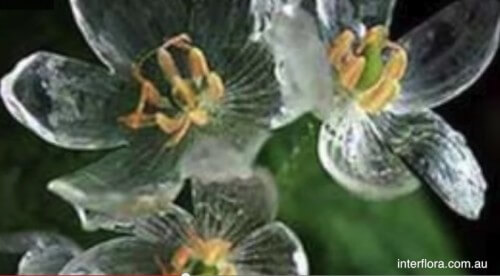The "skeleton flower" recently discovered in East Asia becomes transparent when it rains

By Yael Halfman Cohen and Yifat Yair
Biomimetic innovation often begins in a moment of wonder at an unusual and strikingly unique mechanism in nature. Various phenomena in nature exemplify different design ideas from what is known and known to us as planners, ideas called Crazy concepts, "crazy" ideas, in the engineering literature.
Such a "crazy" idea is demonstrated, for example, in the "skeleton" flower (Diphylleia Grayi: Skeleton flower), which was recently discovered in the region of East Asia and Japan. The inflorescence of this perennial plant rises to a height of about forty cm and a width of about a meter, and blooms from mid-spring to early summer, in shady conditions.
At first glance, the flower bloom looks ordinary, but after contact with the raindrops, the petals of the flower become transparent and shine like glass. When the rain stops, the petals dry and return to their white color. You can see the phenomenon in the following video:
The flower has hardly been studied and there is no documentation about it in the literature. One can only speculate what the reasons for this amazing phenomenon could be. for example:
1. Pollination is more effective - petals that are wide open in a structure known as a "saucer flower" (similar to an anemone) allow pollination by insects. It is possible that the transparency hides the petals from unwanted potential pollinators that reach the flowers in the rain, so the pollination is less effective due to the humidity. The transparency may be related to the disappearance of the "landing tracks" which direct pollinators to the stamens and nectar in the center of the flower.
2. Reducing harm from pests - maybe the rain encourages harmful insects to reach the plant and the transparency does not allow them to see where to land.
3. Prevention of water accumulations - it is possible that the rainwater is absorbed by the petals and apart from transparency causes additional phenomena such as the degree of roughness of the surface or the degree of their concavity. The transparent petals look flatter and perhaps this prevents water from accumulating inside the flower which damages the pollen.
The flower is currently sold as an ornamental flower with a unique "gimmick", but if we understand the mechanism of the temporary transparency of the flower we can develop innovative biomimetic materials that become transparent when in contact with water. Possible applications for such materials can be identified, for example the transparency of flower pots as a measure of soil moisture. Perhaps we could also use the mechanism in reverse and develop transparent materials that turn white on contact with water, ideal for showers in public places.
https://www.youtube.com/watch?v=84YboMfyzjo

5 תגובות
How difficult was it to wet him and show how he gradually turns into a chicken?
Hmmm
As I commented, my guess is the plant acts like a tissue paper. I will settle for toilet paper.
Maybe it's just made of toilet paper?
If the plant grows in a place where there is not an abundance of water. My bet is that it is a rainwater absorption mechanism (water for the plant to use later). Water is an essential raw material for plants, if they do not have abundant water they will do their best to capture occasional water or store it. The cacti are known to store water in their green tissue, because they grow in areas with little precipitation.
If this plant grows in the tropics my guess falls (wrong). They said he grew up in Japan, we'll check what his longitude is.
It is possible to engineer a plant that changes color or becomes transparent when exposed to a pollutant. For example, in an area where there is radiation, the flower is transparent. And the plant is colored where the nuclear pollution has ended.